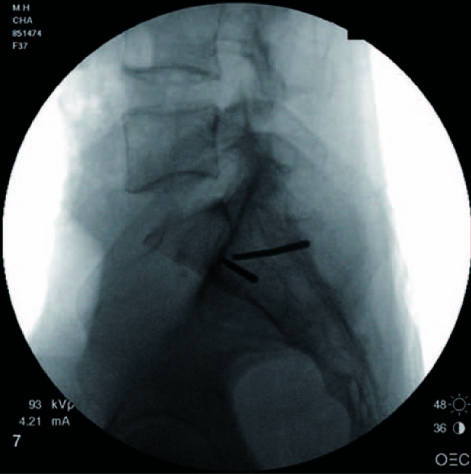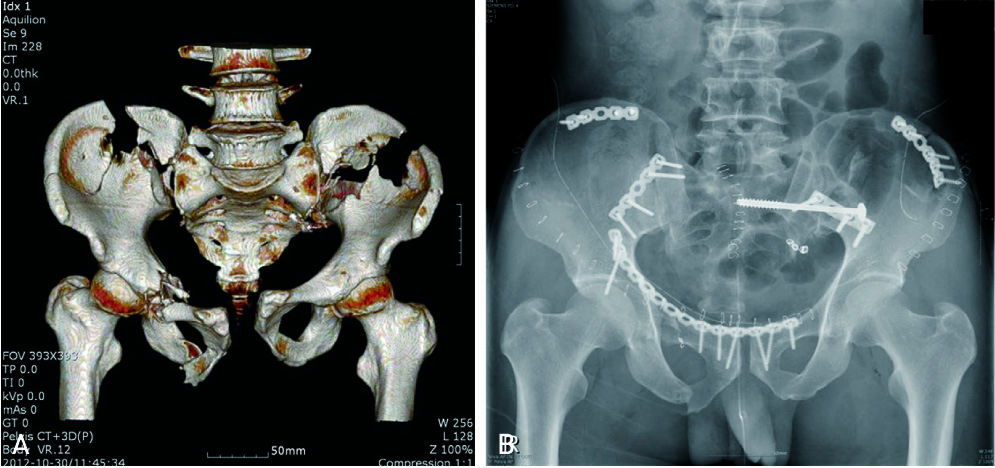Hip Pelvis.
2014 Jun;26(2):79-83. 10.5371/hp.2014.26.2.79.
Treatment of Unstable Pelvic Ring Injuries
- Affiliations
-
- 1Department of Orthopedic Surgery, Daejeon St. Mary's Hospital, The Catholic University of Korea, Daejeon, Korea. weonkim@hotmail.com
- KMID: 2054168
- DOI: http://doi.org/10.5371/hp.2014.26.2.79
Abstract
- Pelvic fractures are classified according to the stability of the pelvic ring. Unlike stable pelvic fractures, which heal without complications, unstable fractures may lead to pelvic ring deformities, which cause severe complications. An orthopedic surgeon must determine the stability of the pelvic ring by radiography and physical examination of the patient in order to ensure early, prompt treatment. This article includes anatomy of the pelvic ring, classification of pelvic ring injuries, its treatment algorithm, and corresponding cases involving unstable pelvic ring injury.
MeSH Terms
Figure
Reference
-
1. Brown TD, Stone JP, Schuster JH, Mears DC. External fixation of unstable pelvic ring fractures: comparative rigidity of some current frame configurations. Med Biol Eng Comput. 1982; 20:727–733.
Article2. Failinger MS, McGanity PL. Unstable fractures of the pelvic ring. J Bone Joint Surg Am. 1992; 74:781–791.
Article3. Kim SJ, Chung HK, Lee KH, Chung ST. A clinical study of the pelvic bone fracture. J Korean Orthop Assoc. 1991; 26:1441–1449.
Article4. Kim WY, Hearn TC, Seleem O, Mahalingam E, Stephen D, Tile M. Effect of pin location on stability of pelvic external fixation. Clin Orthop Relat Res. 1999; 361:237–244.
Article5. Kim WY, Ji JH, Kim YY, Yang YJ, Lee DY. Anterior fixation techniques on unstable pelvic ring injury. J Korean Orthop Assoc. 2005; 40:8–13.
Article6. Pennal GF, Tile M, Waddell JP, Garside H. Pelvic disruption: assessment and classification. Clin Orthop Relat Res. 1980; 151:12–21.
Article7. Bosch U, Pohlemann T, Tscherne H. Primary management of pelvic injuries. Orthopade. 1992; 21:385–392.8. Routt ML Jr, Simonian PT, Ballmer F. A rational approach to pelvic trauma. Resuscitation and early definitive stabilization. Clin Orthop Relat Res. 1995; 318:61–74.9. Goldstein A, Phillips T, Sclafani SJ, et al. Early open reduction and internal fixation of the disrupted pelvic ring. J Trauma. 1986; 26:325–333.
Article10. Tile M, Pennal GF. Pelvic disruption: principles of management. Clin Orthop Relat Res. 1980; 151:56–64.
Article11. Tile M. Pelvic ring fractures: should they be fixed? J Bone Joint Surg Br. 1988; 70:1–12.
Article12. Copeland CE, Bosse MJ, McCarthy ML, et al. Effect of trauma and pelvic fracture on female genitourinary, sexual, and reproductive function. J Orthop Trauma. 1997; 11:73–81.
Article13. Johnson KD, Cadambi A, Seibert GB. Incidence of adult respiratory distress syndrome in patients with multiple musculoskeletal injuries: effect of early operative stabilization of fractures. J Trauma. 1985; 25:375–384.
Article14. Peltier LF. Complications associated with fractures of the pelvis. J Bone Joint Surg Am. 1965; 47:1060–1069.
Article15. van Gulik TM, Raaymakers EL, Broekhuizen AH, Karthaus AJ. Complications and late therapeutic results of conservatively managed, unstable pelvic ring disruptions. Neth J Surg. 1987; 39:175–178.16. Young JW, Burgess AR, Brumback RJ, Poka A. Pelvic fractures: value of plain radiography in early assessment and management. Radiology. 1986; 160:445–451.
Article17. Bucholz RW. Pathomechanics of pelvic ring disruptions. Instr Course Lect. 1987; 10:167–169.18. Mears DC, Capito CP, Deleeuw H. Posterior pelvic disruptions managed by the use of the Double Cobra Plate. Instr Course Lect. 1988; 37:143–150.19. Matta JM, Saucedo T. Internal fixation of pelvic ring fractures. Clin Orthop Relat Res. 1989; 242:83–97.
Article20. Routt ML Jr, Simonian PT, Agnew SG, Mann FA. Radiographic recognition of the sacral alar slope for optimal placement of iliosacral screws: a cadaveric and clinical study. J Orthop Trauma. 1996; 10:171–177.
Article21. Gras F, Marintschev I, Klos K, Mu¨ckley T, Hofmann GO, Kahler DM. Screw placement for acetabular fractures: which navigation modality (2-dimensional vs. 3-dimensional) should be used? An experimental study. J Orthop Trauma. 2012; 26:466–473.22. Mears DC, Fu FH. Modern concepts of external skeletal fixation of the pelvis. Clin Orthop Relat Res. 1980; 151:65–72.
Article23. Lee S, Bae SU, Jung WK, Kim CH, Kim JH. Treatment of the unstable pelvic fracture by external skeletal fixation. J Korean Orthop Assoc. 1992; 27:1818–1826.
Article24. Slätis P, Karaharju EO. External fixation of unstable pelvic fractures: experiences in 22 patients treated with a trapezoid compression frame. Clin Orthop Relat Res. 1980; 151:73–80.25. Liu J, Lai KA, Chou YL. Strength of the pin-bone interface of external fixation pins in the iliac crest. A biomechanical study. Clin Orthop Relat Res. 1995; 310:237–244.26. Gänsslen A, Hildebrand F, Kretek C. Supraacetabular external fixation for pain control in geriatric type B pelvic injuries. Acta Chir Orthop Traumatol Cech. 2013; 80:101–105.
- Full Text Links
- Actions
-
Cited
- CITED
-
- Close
- Share
- Similar articles
-
- Operative Treatment of Unstable Pelvic Ring Injury
- Testicular Dislocation Associated with Pelvic Ring Injury
- Surgical Fixation of Sacroiliac Joint Complex in Unstable Pelvic Ring Injuries
- Percutaneous screw fixation and external stabilization as definitive surgical intervention for a pelvic ring injury combined with an acetabular fracture in the acute phase of polytrauma in Korea: a case report
- A Clinical Study of the Unstable Pelvic Bone Fracture





